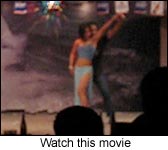| Tuesday, February 28 Since I didn't take my beloved computer to the south when I went there last July and August, there were lots of things I saw and photographed that I wanted to write about but didn't get a chance to until it seemed too late. Some of the things have stuck with me though so I might as well write about them from time to time, as well as things from Kathmandu. Lots of people had told me to take a look at the craft shops in Kochi -- apparently because of all the tourists there are some nice arts and crafts.
Besides being grotesque rather than beautiful, I did not see how in any way this item could pass off as local handicraft. I asked the woman running the shop what this was exactly? A sculpture of some sort? Turning it to me, she said (and I read), "It's the Jolly Nigger bank. You put a coin in its mouth and then you can press a lever in the back and it spits the coin onto on the hand. Isn't it clever?" I goggled for a bit. "Oh," I
said, finally. Then: "Um, where is it from? Is this made here?" I asked. (Imagine a South Indian workshop mass producing these things - what a story!) "I'm not sure, we get a lot of things from around the world," she said. "I think this is from Nigeria?" "Really?" I tried for a moment to imagine this item being made in Nigeria and exported to India. It seemed an unlikely story. By this time, given the strong interest I appeared to be showing, it was clear she thought she had a sure customer for the ghastly thing. I told her I was really interested in knowing where the bank was made and she said she'd ask the shop owner and find out for me. I can't remember now whether I went back there and she was unable to find out or whether I dropped my investigation. But at any rate, she let me take pictures of it. Perhaps I should google search "Jolly Nigger bank" to find out who makes these things. And is there really a market for them? I hope not. Non sequitur, from late at night I like it when people use pseudo-algebraic things to make sense of experiences that are not on the face of it explainable by mathematical rules. One of example of this is a travel story a coworker of mine once did that started off with a little equation that took one variable to represent the amount of time spent traveling to a place and subtracted it from the amount of time spent at the place to measure the worthwhileness of going to the place in question. Another example I saw recently was from a piece by the authors of Freakonomics (a facile and overrated book) that drew upon a paper that used variables to measure the likelihood that prostitutes would or wouldn't use condoms with their johns. I looked at the original paper and there was something so wistful and beautiful about sex and risk being mapped out in this way. It seemed so wishful. Poor sad human beings, always trying to explain the unexplainable. Here is an excerpt: Let
Richard’s utility (maximum willingness to pay) from having unprotected
sex (from “Sex Sells, But Risky Sex Sells for More,” by Paul Gertler, Manisha Shah, and Stefano Bertozzi) The reason that I bring this up is that I find I like to apply a mathematics of sorts to my own romantic life, though not of a very precise kind. I mix up hard facts, like dates, with soft facts, like an arm that rests too long on someone's shoulders, to try and pinpoint when it was exactly that a particular person spun out of my orbit and into another's. True, it's not algebra, so much as astronomy, and as a mental exercise I'm not sure what purpose it serves. But somehow it feels as if, if I can pinpoint how different axes intersect and what laws of gravity or magnetism create certain constellations, then "eureka!" I'll be a bit closer to understanding the physics of attraction. Wednesday, February 22 People are always texting each other here and though I think it's a really good and cheap way of communicating I am severely handicapped by my unwieldy thumbs and hand-me-down French phone. It was my mother's and the English dictionary was clearly designed for a specific English-speaking population (British) and by people who are probably not texting in English themselves. So for instance, trying to type "nyc" brings up "oxbridge," while an attempt at "kisses" brings up "kipper" (will try not to read any message from the universe into this substitution). I suppose my texts must be very plebeian, but I just can't imagine a world in which one would really need to type a text message containing these two words. Still, I suppose the good people at Alacatel can (ex: thks 4 the kipper brkfst luv. So very oxbridge." or perhaps "Done mtg oxbrige don. Right old kipper."). So it doesn't make for a very good dictionary for me, but it does make for an enjoyble reverie about what French people think English people are thinking about. I do wish they would have included of, one, my, might and maybe. I wonder what sort of English words there are in Indian-made cellphones. "Prepone," I'm sure and "needful," I hope. Sunday, February 19
The wedding season seems to be having its last gasp as Delhi heats up. A baraat has been making its way past my window, band and all, for the past three hours this evening. Sunday, February 12 Quibbles 'n' bits More signs of growing old are upon me. I discovered a white hair. In my eyebrow. Who gets white hair in their eyebrows? I have plucked it out. It might be paranoia but I think my face is falling down. I can't be quite sure though because I find when I look in the mirror for too long and too close my reflection wanders off into some Picasso-like zone and I can't tell any more what I'm looking at. The other sign of old age is that I can no longer drink, at least not to my heart's content. My constitution rebels against alcohol very ferociously these days. One drink -- one! -- say something as innocuous as a gin and tonic is enough to provoke nausea. I suppose it's all tea and hot chocolate from now on.
Thursday, February 10 Little
monks and tiny brides On the last of my 10 days of work in Kathmandu, I went to Patan. Patan to Kathmandu, in terms of geography and relationship is like Noida to Delhi or Brooklyn to Manhattan – part of a greater whole but separate. In terms of aesthetics, it's cuter, more densely packed with temples for its size.
In another temple we went to, there was graffiti in chalk all over one of the stupas, which I thought was very sensitive. It wasn’t just graffiti but a sort of offering to the goddess of wisdom, Saraswati, so all the little children who were starting to learn to read and write had chalked their names for her. And finally, in the last temple we peeked into, we saw lots of girls, aged about the same as the monks, all dressed in red wedding finery, stumbling about in gold-embroidered saris, makeup and bangles. They were Newari girls and what they were doing was taking out a sort of insurance sagainst the misfortune of ever becoming a widow – a horrible thing in South Asia. Their parents were marrying them to bhel fruit – I think this is a green fruit with a whitish inside but I’m not sure (that is why I drew a pineapple) – so the girl can never truly be a widow. The fruit goes with here when she has her second marriage, to her husband’s house. I like the idea very much – it seemed a way to trick fate – but I wonder if it really makes a difference to how a woman is treated when her human husband dies.
|
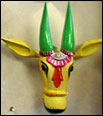 I
didn't really have all that much money but there were one or two people
I wanted presents for and I thought it would be nice to take something
local for relatives up north. Of course the most local and authentic
thing would have been pepper but it doesn't seem like the sort of
gift people would receive with the same joy they would have in, say,
1429. Anyway, so what I had in mind was something like this -- I don't
know who produces it or what cultural style it is -- but it is a wooden
painted cow's head to be stuck on a wall. But at one craft shop I
saw something quite different. Something that made me think, not for
the first time: Indians are so fucked.
I
didn't really have all that much money but there were one or two people
I wanted presents for and I thought it would be nice to take something
local for relatives up north. Of course the most local and authentic
thing would have been pepper but it doesn't seem like the sort of
gift people would receive with the same joy they would have in, say,
1429. Anyway, so what I had in mind was something like this -- I don't
know who produces it or what cultural style it is -- but it is a wooden
painted cow's head to be stuck on a wall. But at one craft shop I
saw something quite different. Something that made me think, not for
the first time: Indians are so fucked. 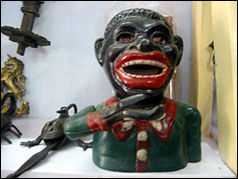 This
is what it was.
This
is what it was.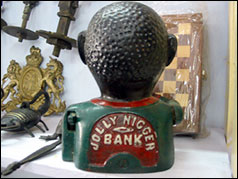
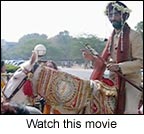

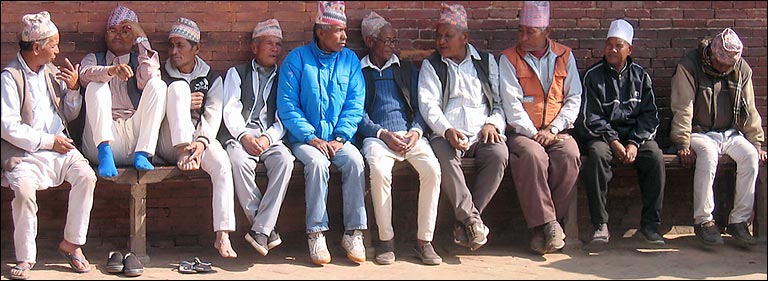
 The
day we went there (with J. and friend of hers, S., who owns a cinema
hall) was Saraswati Puja and the first day of spring so the town square
– which reminded me of some medieval European town squares with
pagodas and lots more carving thrown in – and the temples were
bustling with activity. It was so cheery that it was hard to believe
that all this celebration was happening against the backdrop of Maoist
violence, elections that were likely to bring about more violence
and a generalized feeling of malaise and hopelessness. But I guess
even malaise takes a holiday.
The
day we went there (with J. and friend of hers, S., who owns a cinema
hall) was Saraswati Puja and the first day of spring so the town square
– which reminded me of some medieval European town squares with
pagodas and lots more carving thrown in – and the temples were
bustling with activity. It was so cheery that it was hard to believe
that all this celebration was happening against the backdrop of Maoist
violence, elections that were likely to bring about more violence
and a generalized feeling of malaise and hopelessness. But I guess
even malaise takes a holiday. We
went to the Buddhist golden temple, where lots of little boys (they
looked about seven or eight) were dressed in bright yellow robes,
with their heads shaved, looking for all the world like so many miniature
monks. They were going to be monks, at least for a few days as part
of a rite of passage that J. says is common among Nepali boys, Buddhist
or otherwise. Meanwhile their sisters were noisily playing catch around
the temple courtyard, which had a sort of wraparound balcony studded
with prayer bells.
We
went to the Buddhist golden temple, where lots of little boys (they
looked about seven or eight) were dressed in bright yellow robes,
with their heads shaved, looking for all the world like so many miniature
monks. They were going to be monks, at least for a few days as part
of a rite of passage that J. says is common among Nepali boys, Buddhist
or otherwise. Meanwhile their sisters were noisily playing catch around
the temple courtyard, which had a sort of wraparound balcony studded
with prayer bells.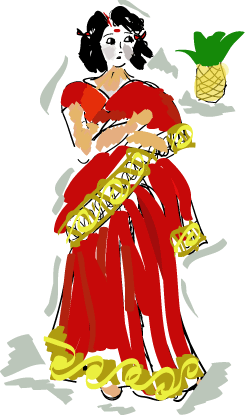 That
night, in a departure from all the temples, I went with many Nepalis
and one Indian to Go Go bar in Kathmandu’s tourist district,
Thamel. The dance performances turned out to be mostly sexed up versions
of Bollywood performances but a couple were quite raunchy, at least
for here, with the girls wearing underwear and shimmying fairly suggestively.
Anywhere else, I think the place would have seemed pretty cute, but
I couldn’t gauge whether locals thought it was sleazy and the
girls likewise. I did see some young Nepalis, all wearing baseball
caps for some reason, there with girlfriends. I liked the music a
lot, especially this one song that sounded like Nadia Hassan doing
a cover of a Laura Branigan song, a bit of which is featured in the
video below.
(1m 30s; 1.6 MB, Quicktime)
That
night, in a departure from all the temples, I went with many Nepalis
and one Indian to Go Go bar in Kathmandu’s tourist district,
Thamel. The dance performances turned out to be mostly sexed up versions
of Bollywood performances but a couple were quite raunchy, at least
for here, with the girls wearing underwear and shimmying fairly suggestively.
Anywhere else, I think the place would have seemed pretty cute, but
I couldn’t gauge whether locals thought it was sleazy and the
girls likewise. I did see some young Nepalis, all wearing baseball
caps for some reason, there with girlfriends. I liked the music a
lot, especially this one song that sounded like Nadia Hassan doing
a cover of a Laura Branigan song, a bit of which is featured in the
video below.
(1m 30s; 1.6 MB, Quicktime)